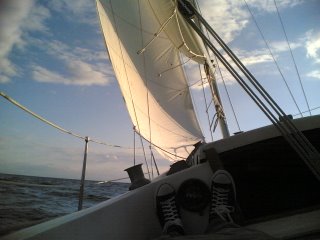
The day after arriving in Toronto, my roommate-for-a-few-days, Maciek, offered to take me out sailing on Lake Ontario. Although it was September, it didn't take me too long to agree. It was pretty good fun. I liked the fact that all of the odd looking wee bits and pieces on the boat actually served some function or other. It was also pretty cool to all of a sudden be very interested in the direction of the wind, relative to where you want to go. Too often these days we take for granted that we have motors and engines to take us wherever we want to go regardless of the environmental conditions.
 We sailed out of Port Credit and headed towards Toronto. Although it was quite far away, the CN Tower still dominated the skyline from our position. We headed towards it for a while. I took a turn of steering (or should that be "navigating" or "piloting"?) and it was a strange feeling. Whenever I turned the tiller one way, there was a short delay as the new angle of the rudder caused the water to deflect off it. I would then realise that I turned it quite far so I would compensate in the opposite direction. For a while the boat was wiggling from side to side as I tried to keep the CN Tower in line with the bow. As time went by, I tried a form of "prophetic steering" where I turned it a bit and then guessed how far I had oversteered before the boat actually turned. Either that or I made smaller adjustments, I don't know which.
We sailed out of Port Credit and headed towards Toronto. Although it was quite far away, the CN Tower still dominated the skyline from our position. We headed towards it for a while. I took a turn of steering (or should that be "navigating" or "piloting"?) and it was a strange feeling. Whenever I turned the tiller one way, there was a short delay as the new angle of the rudder caused the water to deflect off it. I would then realise that I turned it quite far so I would compensate in the opposite direction. For a while the boat was wiggling from side to side as I tried to keep the CN Tower in line with the bow. As time went by, I tried a form of "prophetic steering" where I turned it a bit and then guessed how far I had oversteered before the boat actually turned. Either that or I made smaller adjustments, I don't know which.On the way back, it was more tricky. This was because the wind had been at our back on the way out and now we had to sail into the wind. "How do you sail into the wind?" I hear you ask. Fear not, I shall explain. It seems that a sailing boat can still use the wind by pointing diagonally past it. In other words, if you were facing into the wind, you could turn say 45 degrees to the left or the right and the wind would propell you in the direction you're facing. How exactly does that work? Well I think the wind kind of pushes past the boat, causing it to move in the direction that has least resistance in the water, which would be the direction it's facing. Also, I suppose you can turn the sail a bit. I don't actually know what I'm talking about. I'm just guessing.
In order to get back to where we started, we had to adopt this 45 degree angle to the wind that I was just talking about. The only problem with that was that we really wanted to go into the wind, rather than off at some angle to a different destination altogether. For that reason we had to do some tacking. This is simply a technique where you travel to the left of the wind for a while and then turn 90 degrees to travel right of the wind for the same distance again. You then keep repeating this until you get to your destination. Think of the direction you want to go as a straight line up and down the way, and the actual path as a zig-zag line that veers off to one side and then turns back across but gets to the end eventually. Ok, that was a rubbish comparison. I basically repeated what I just said. Undaunted, I carry on...
Sailing into the wind is a bit slower than having it behind you, as one might expect. For this reason, we changed the front sail to a bigger one to help speed things up. This was pretty good fun. I had to go to the bow (front for you landlubbers) of the ship and lower the front sail, unclip it and gather it into a big bag. I then had to repeat the process in reverse to attach the larger sail. It was great fun. All that bouncing up and down made me slightly sea-sick but it was good to feel alive again.
 The return trip was much bouncier and the boat tended to lean to one side quite impressively. Maciek assured me that it would be impossible for the boat not to right itself in the event of an extreme "leaning" (?) situation. The reason for this is that the keel is very heavy compared to the weight above the water. Basically, that means if it capsizes it'll right itself. Thankfully no capsizing occured, although a jaunty angle was entertaining in its own way.
The return trip was much bouncier and the boat tended to lean to one side quite impressively. Maciek assured me that it would be impossible for the boat not to right itself in the event of an extreme "leaning" (?) situation. The reason for this is that the keel is very heavy compared to the weight above the water. Basically, that means if it capsizes it'll right itself. Thankfully no capsizing occured, although a jaunty angle was entertaining in its own way.
No comments:
Post a Comment